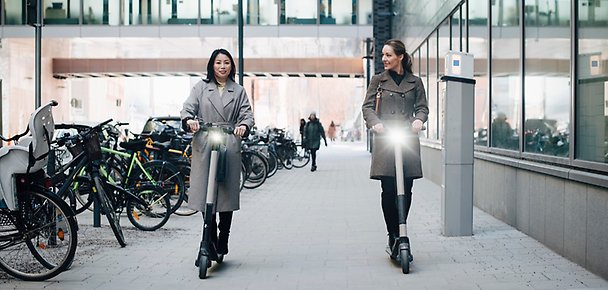
Field: Innovationsförmåga
How does the EU work with regulations of new technology and at the same time focus on green transition?
The “pacing problem” refers to the different pace between technological change and the pace at which traditional regulation respond, which is often lagging and may hinder or slow down technological change. This report describes how such issues are discussed within the EU and in particular its role in the green transition.
The report is a partial study within the Growth Analysis framework project “How does regulation affect Swedish competitiveness?”. In a previous partial study, we reviewed the research literature regarding the pacing problem in general.
Research on the pacing problem
According to the research literature review that Growth Analysis published earlier this year (Tillväxtanalys Report 2022:04), an important measure to reduce the pacing problem is a new approach to regulating new technology. The approach is called adaptive and assumes that the external conditions are changeable and that the regulations consequently cannot remain the same for long. The adaptive governance model includes a number of concrete policy tools. Growth analysis has developed a model that schematically shows important issues for an adaptive regulatory process. The model is circular rather than linear and iterative rather than sequential.
Adaptive governance has existed for a long time within the EU
The EU uses, in line with what the research prescribes, various forms of adaptive governance. For example, ongoing reviews of existing regulations, framework directives with simpler procedures for adaptation to changes in the environment and time-limited review clauses are carried out. This also applies to the green transition, which is the focus of this report. The EU's environmental legislation contains many examples of rules that have been gradually adapted to developments, including new technological developments. At the same time, there has been criticism that, on the one hand, rules sometimes hinder new solutions, on the other hand, the adaptive control tend to lead to deregulation with increased risks.
For about ten years, the EU has been working systematically to ensure that regulations favor innovation. Effects on innovation must, according to the so-called innovation principle, be analyzed within all relevant policy areas. Dealing with the pacing problem is among the motives. Methods such as so-called regulatory sandboxes have become more common in the Member States, not least in terms of financial services and digitization. This has led to a discussion that the EU's common regulations should also favor such working methods, of which there are examples.
A central question in the discussion above is what freedom the member states should have and what the EU should regulate. Common guidelines for regulatory sandboxes are underway. There are also proposals that certain sandboxes and experimental clauses should be common to the entire EU.
There is no systematic technology monitoring directly linked to the development of rules at the EU Commission, which is the only institution that can put forward proposals for rule changes. However, the EU Parliament and individual Member States have bodies that do such work. However, the European Commission develops technology intelligence in specific areas such as health innovations and safety-related technologies and do analyzes of megatrends and other strategic foresight.
The EU has a system for continuous learning and rule evaluation as part of the work on better regulation, where the guidelines and toolkit have recently been updated. However, the effects are still uneven between different policy areas and specific regulations.
The pacing problem for the green transition
Within the area of the green transition, there is also an awareness of the pacing problem. The European Commission is working in several ways to facilitate the use of cutting-edge new green technologies, including speeding up permitting processes. However, it is too early to say that there is a fully developed strategy. The pacing problem is however not at the center of the, approximately 50 other, new regulations within the so-called green deal. The development has come further in terms of financial services and digitization.
The interest in methods such as regulatory sandboxes in the area of the green deal applies especially to the transformation of the energy sector. Preliminarily, the EU Commission will present guidelines for this in the second quarter of 2023.
There are also examples of increased scope for testing new technology, for example in the proposal for new regulations for industrial emissions. Companies that want to use cutting-edge technologies may be given more time to meet certain conditions, and a dedicated innovation center will be set up to provide support. However, the proposal is controversial, and it is uncertain what the outcome of the negotiations in the Council of Ministers and the EU Parliament will be.
The green transition of carbon dioxide-intensive industries such as steel and cement manufacturing are a priority area with many policy efforts at EU level. The pacing problem is highlighted, among other things, through calls for faster permit review. The plans for greatly increased use of hydrogen contain examples of adaptive control, but there is a lack of an overall assessment of the relationship between risk and experimentation. In chemicals policy, however, there have long been methods for assessing the need for regulation in relation to the risks of innovation.
Commission officials must, according to the general guidelines, analyze opportunities for soft legislation before proposing binding rules. However, experience so far has been mixed. An example is reduced carbon dioxide emissions from new vehicles. There, the EU first tried voluntary commitments from the car industry, but then opted for binding requirements when the promises were not fulfilled.
Several policy documents describe the balance of power between established and new businesses as a central issue, but how it is handled differs between different areas. Ongoing negotiations on the reform of the EU's emissions trading show that the balance of power between forerunners and laggards among incumbents is also an important issue.
The EU has a nuanced view of the relationship between rules and innovation. Policy documents and responsible officials in the Commission describe the need for both a framework for regulating new technologies and the importance of being able to experiment. Many factors influence the pace of the green transition. The EU lacks a comprehensive analysis of the importance of instruments such as regulatory sandboxes compared to others. Research shows that environmental regulations are often important for speeding up technology development due to market failures.
This report provides an overall picture of common ambitions at EU level, but does not include how these ambitions are applied in individual Member States. The relationship between the nation-state level and EU policy is one of the areas that could be enrich further studies, including the possible need for coordination of methods such as regulatory sandboxes.
How does the EU work with regulations of new technology and at the same time focus on green transition?
Serial number: Rapport 2022:12
Reference number: 2021/50
Download the report in swedish Pdf, 838.7 kB, opens in new window.
A partial study of the project:
Delstudier i projektet
Den här studien är en del av ett kunskapsprojekt där följande studier också ingår.






